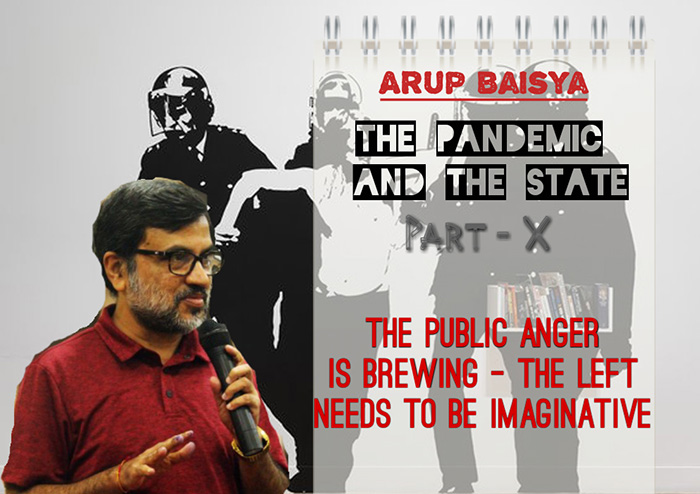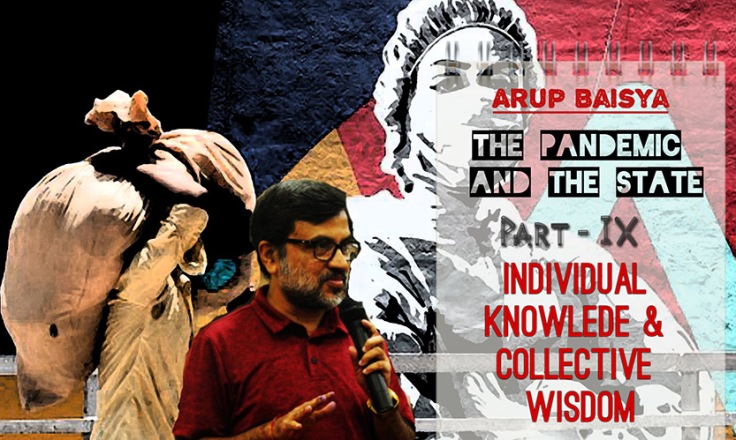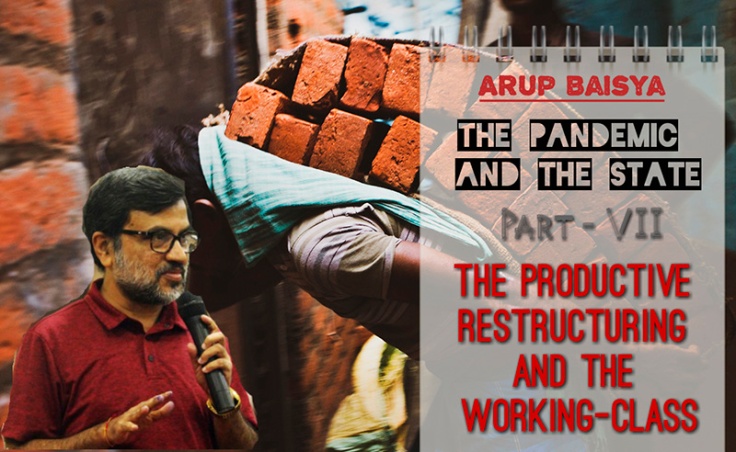The Pandemic and the State: Part-x (Last): The public anger is brewing – the left needs to be imaginative
Arup Baisya

The Government policy of unplanned lockdown, the dilapidated health infrastructure, and health facility skewed in favour of the rich and the Government’s lack of intent in the building of mass-awareness and capacity for universal free healthcare facility to contain COVID pandemic for the fascination in promoting Hindutva ideology of the present dispensation had dismantled the banister which the party in power could catch hold of in the slippery slope of Indian economy. The Government allowed the COVID pandemic to snowball into a human disaster prioritizing the Hindutva agenda to pursue over the saving of lives and livelihood. Some observers foresaw the return to Keynesianism in the backdrop of global as well as national human disaster both due to COVID disaster and natural disaster for global warming. Both are the offshoot of the capitalist mode of production that creates a metabolic rift between humans and nature, and this is accentuated by the neoliberal policy persuasions. The so-called golden age of Keynesianism emerged from a human disaster of incomprehensible dimensions, but this time the return to Keynesianism seems implausible, the viable alternatives are barbarism or socialism. In the developing countries like India, the task for the democratization of state and society and to combat the activation of coercive state apparatuses to curtail democratic rights is ingrained within the overarching ambit of working-class struggle.
The Working Class and the left
In the pre-pandemic neoliberal global economy, we observed a massive extension of the service sector. This was because the capital could no longer be valorised in industrial production. The change and diversification of the consumption pattern facilitated capital accumulation in this sector. The service sector is ingrained in the capitalist production process for exchange for consumption due to the presence of diverse forms of mediation for the circulation of capital for the return of capital in the production process again. But the development of the service sector as an independent sector for profit and accumulation of capital is the latest development of capitalism and this sector recorded a huge boom in the neoliberal phase. The immense rise of the organic composition of capital both in the developed and developing countries due to the rise in fixed capital in comparison to variable capital has transformed a large amount of capital idle. The high rate of accumulation of capital in the few pockets of the capitalist class has a negative impact on consumer demand which leads to the crisis of over-production. When the production of consumer goods is curtailed due to lack of consumer demand, it subsequently also reduces the demand for production of means of production. The idle capital which does not find any profitable destination for investment has been transferred into the service sector which has developed in diverse forms of social and cultural dimensions. The service sectors do not add use-value to the commodities produced by productive labour, but merely add exchange values by the workers in service sectors at different levels to make the products available for the consumption of consumers. The transport sector transfers the commodity from one location to another for consumptions, the service workers add exchange values for the capitalist to accumulate profit at various points in space-time. But it is expected that the growth of service sector would stimulate the demand for the requirement of consumer goods e.g. if transport sector grows, it will create a demand for cars, if service for cultural consumption grows, it will create demand for more TVs, electronic appliances and other related goods. But the transfer of capital accumulated from the service sector to the productive sector has not happened. This accentuated the capitalist crisis and created a situation for both the production and service sector to collapse indicating the collapse of the capitalist economy itself. The left forces neglected the potential strength of the workers in service sectors to transform themselves into a revolutionary class and considered them as a precariat for routinised supportive activities. This is mainly due to the mechanical reading of the communist manifesto. This has become most glaring when the Indian migrant workers revolted against the system through an indirect and primitive form of mass exodus. The left then spelled out a language of criticism against the powers-that-be without formulating a strategy to lead this revolt from the front for a revolutionary transformation. There is another dimension of the left’s role in the present crisis. The old guards of the left circle have lost imagination and imbued with routinised activities and enjoyed satisfaction by glorifying their past deeds. The new guards are confused to think that every popular reaction is anti-systemic and only criticism of the power-that-be from above is the central focus for a revolutionary change.
Monetary and labour policy and its ramification
In this situation of a deep systemic crisis of the capitalist economy, the pandemic and lockdown caused the production and labour process to come to a halt and disrupted even the value chain of the service sector. The Indian Government reacted with the monetary policy of infusing bank credit money into the system. Crisil ratings are optimistic in stating that a slowdown in bank lending may be bottoming out this fiscal, while gross credit off-take may rise 8-9% year-on-year in fiscal 2021 backed by retail demand. The Bank loan may grow at about 6% this fiscal, the rating firm said.
But at the same time, corporate lending (excluding lending to NBFCs) is expected to remain subdued in fiscal 2020 and thereafter, may witness a slight uptick. Crisil projected a modest 2-3 percent rise in this segment, leading to a fall in its share in total bank credit to 48 percent at the end of March 2021 from 51 percent three summers back.
“Low capacity utilisation in the economy would keep private investments muted in the near to medium term, and the government’s mega-push to infrastructure will translate into credit growth only gradually,” Crisil said.
This means that the Government policy of extending credit money does not translate into productive investment, rather the capitalists accumulate more capital by selling their stock of products at inflated prices because the credit money flow into the economy caused inflation of consumer goods. The prices of medicines and health equipment along with other consumables are soaring. Consumer Spending in India decreased to 21250.99 INR Billion in the first quarter of 2020 from 21823.52 INR Billion in the fourth quarter of 2019. (https://tradingeconomics.com/india/consumer-spending). But India’s retail inflation measured by the Consumer Price Index (CPI) rose to 6.93 in the month of July as food prices continued to rise due to disruptions in supply chains, data furnished by the National Statistical Office (NSO) showed.
This inflationary pressure which facilitates the capitalists to increase their profit margin in the sale of accumulated stocks will further increase the income-inequality, but this does not result in productive investment and generation of employment. This is revealed in the data which shows that India’s industrial production slumped by 16.6 percent from a year earlier in June 2020, following a 33.9 percent plunge in the previous month and compared to market expectations of a 20.0 percent contraction. Manufacturing production shrank by 17.1 percent, mining output was down 19.8 percent and electricity supply dropped 10.0 percent. From April to June, industrial production tumbled 35.9 percent. (https://tradingeconomics.com/india/industrial-production). The monetary credit support in the domestic front even in the imperialist centers or the metropolis dries up the credit money required for promoting international trade. This is the reason why External Debt in India decreased to 558548 USD Million in the first quarter of 2020 from 563938 USD Million in the fourth quarter of 2019. (https://tradingeconomics.com/india/external-debt). Despite the fact that the people are living hungry or half-starved and the domestic demand for consumption of essential commodities are dwindling both due to increase in unemployment and the fall in real income for inflation, the agricultural exports rose 23% to Rs 25,553 crore in March-June this year despite the disruption caused by the pandemic. This indicates the continued flight of capital from India to metropolis for low-priced export in the backdrop of income-deflation of Indian toiling masses.
In the backdrop of the emerging signs of a shift from US centric globalization to China centric globalization, Indian Government’s expectation of a transfer of foreign investment from China to India in productive sector is misplaced. Form the global context, the value of labour-power in India is extremely low and it is lower than China. The policy of the Indian Government to further lower the value to attract the investors for a shift in destination from China to India in manufacturing sectors is extremely naïve, because the policy of labour arbitrage of the oligopolistic investors not only rely on the low-value of labour-power but also on productivity of labour. But the productivity of labour is however much higher in China than in India. Why productivity of labour is an important consideration for the investors along with the value of labour-power to make profit can be shown with a quite simple arithmetic. Let us suppose 100 number of items can be produced in a day by 10 number of workers with Rs.100 wage per worker for eight hours of work. It means 100 number of products are produced with a variable capital of Rs. 1000. But with enhanced productivity of workers, if the same number of products can be produced by 5 number of workers with Rs.110 wage per worker, the investment as variable capital comes down to Rs. 550. The productivity is increased with new machinery in means of production and this necessitates additional expenditures for skill development. To offset this disadvantage and to attract foreign and domestic capital investment, the Indian Government is inclined towards increasing the rate of exploitation of workers by increasing the daily working hours from 8 hours to 12 hours and by reducing the minimum wage. That is why Indian Government has proposed the amendment of existing labour laws. But this policy drive of the Indian Government is destined to fail in the backdrop of an overall crisis of capitalism when the investors are not kin on taking risk without being assured of profit and accumulation. This policy of the Government will further dampen the consumer demand and lead the country into further economic downslide.
The policy of super-exploitation of the toiling masses will keep the only option open for the ruling dispensation of transforming the state into an absolutist fascist state for their failure of even achieving the temporary revival of economy and containing the growing discontent in the minds of the people.
The need, desire, and dialectics
When the economy is showing the sign of deep systemic crisis due to the massive accumulation of capital, increased rate of the organic composition of capital and lack of transfer of credit money as capital to productive sectors for the rise of the average rate of profit by engaging the living labour with the dead labour, it can be presumed that the working class is simmering with mental agony developed from the need to achieve their lost status of living and livelihood. The transformation of this immediate need of the toiling masses into a revolutionary desire for radical change depends on the subjective forces and their strategic goal for the emancipation of the working class. This working class is not classical industrial working class alone, the large section of the migrants, the service workers, and the new technological mental workers who are losing jobs in largescale constitute the revolutionary class.
Jean-Paul Satre said in individual praxis as totalization, “…It is through need that the first negation of the negation and the first totalization appear in matter. Need is a negation of the negation in so far as it expresses itself as a lack within the organism and need is a positivity in so far as the organic totality tends to preserve itself as such through it. The original negation, in fact, is an initial contradiction between the organic and the inorganic, in the double sense that lack is defined in relation to a totality, but that a lacuna, a negativity, has as such a mechanical kind of existence, and that, in the last analysis, what is lacking can be reduced to inorganic or less organised elements or, quite simply, to dead flesh, etc. From this point of view, the negation of this negation is achieved through the transcendence of the organic towards the inorganic: need is a link of univocal immanence with surrounding materiality in so far as the organism tries to sustain itself with it; it is already totalising, and doubly so, for it is nothing other than the living totality, manifesting itself as a totality and revealing the material environment, to infinity, as the total field of possibilities of satisfaction….”
The existing capitalist crisis is not only the Kondratieff long cycle crisis or a deep structural crisis, but it also means the crisis of reproduction of labour and nature depending on which capitalism sustains through profit and accumulation. How the future will unfold itself and how the social relation of production remoulds itself based on the victory of either of the two combatants, labour and capital, will reveal itself in the human consciousness through praxis. It is the human praxis through which the Marxist dialectics become operative, not in a proven theoretical framework but as a process that begins with praxis. The human action is itself the negating transcendence of contradiction and that action in the form of praxis is the negation of transcendence of contradiction. The practicing humans who are part of the present can unveil the present not as totality, but as totalization in the name of future totality, the future is the transformation of the present into the future which again becomes the present as a totalization of another totality. The entire historical dialectic rests on individual praxis in so far as it is already dialectical.
Marxist Strategy
The formulaic version of Marxism debars the Marxist practitioners from continuously going deep into the changing dynamics of the social relation of production through praxis and act according to the need which appears as totalization to transform it into a desire of the toiling masses through befitting strategic and tactical action.
The present dispensation in power, while acting in favour of the capitalist through monetary measures, privatization and selling out of the public property to the private capitalists at through-away prices, is missing the bush in search of the trees and will soon lend into a quagmire for policy paralysis or coercive state apparatus by failing to revive the economy. The needs of the toiling masses and new working class thus generated due to degradation of their existing social status and living standard can only transform into a desire for radical change only through struggle and massive collective action which only the left forces can lead only through their deeper understanding of Marxist philosophy of praxis and strategic programme thereon. The left must come out of their reformist mindset and bargaining form of trade unionism for launching collective action against privatization and for socialisalisation of means of production and social welfare and employment.











